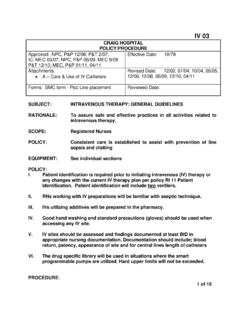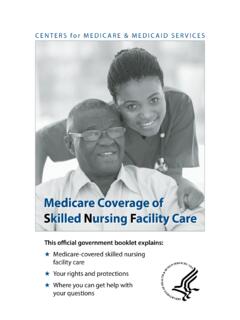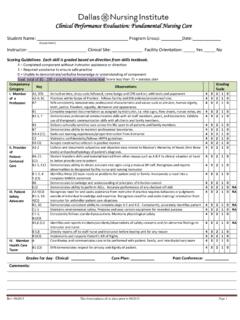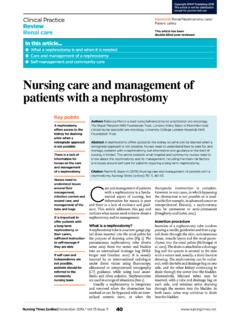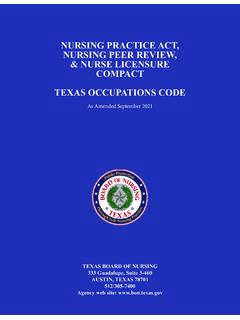Transcription of Nursing Care Plan Guidelines - Craig Hospital
1 Nursing care Plan Guidelines Age: _____ Date Admitted: _____ Diagnosis: _____ Occupation: _____ Religion/Culture/Ethnicity: _____ Student: _____ Date of care : _____ Date: _____ Nursing Diagnosis: Assessment with subjective & objective data Patient goals & objectives Patient Interventions: I or patient I Outcome/Evaluation format Prioritize Nursing diagnosis (dx) Give specific & complete subjective & objective data that support Nursing dx Give a picture of patient with this problem you identified Nursing Dx should be from NANDA and in 3 parts: 1- ,2-related to (r/t) _____, 3-as evidenced by (AEB) _____. Many ways to prioritize Maslows Hierarchy, functional level, pathophysiology r/t etiology, factors that cause or contribute to problem AEB signs & symptoms exhibited by THIS patient This is what you want to happen to resolve/prevent the stated problem.
2 Put in patient behavioral terms Goals help determine the Nursing interventions necessary for the next column Goals must be realistic, specific, measurable, action oriented, & with a time frame You must be able to evaluate these goals (last column) so you must have criteria here than can be measured in some way Think of goals you as the nurse can help patient achieve with your interventions Number & list specific actions you plan to help pt. achieve goals Use active language Think about this in documentable terms Do no use encouraging or try words that are vague Use words like teach, explain, provide, monitor, administer, assess, consult/collaborate, report, etc. These are client specific & individualized Consider needs, preferences, limitations of patient Standardized care plans are fine, but you must individualize Check list of items, one for each of the interventions listed Place checkmarks to indicated that you did it, and if not, put in evaluation column WHY you did not Address same categories as in the goals & objectives column Ask yourself, was that goal met & indicate here.
3 For example, goal was that pt. would walk hall length 3x/day. Put here pt. walked hall 2x/day (whatever the pt. really did) This is the accountability area. If goal not met, document new goal or added time if that is necessary Sample Nursing care Plan 1 Nursing Diagnosis: Assessment with subjective & objective data Patient goals & objectives (patient-centered, measurable and timed) Interventions with rationale (what you ll do and why) Implemented (yes/no) Outcome/Evaluation Objective: Patient not oriented to place or time Patient unable to concentrate Subjective: Patient non-verbal, uses nonsensical words Diagnosis: Chronic confusion related to traumatic brain injury AEB disorientation and cognitive dysfunction. 1. Patient will be oriented to self within three weeks. 2.
4 Patient will be oriented to person, place and time by discharge. 3. Patient will be able to perform basic ADLs by discharge independently. Identify self and patient by name at beginning of each interaction. (consistent orientation may help memory) Maintain calm environment (decreases anxiety, promotes rest) When patient perseverates, redirect attention to another topic (decreases anxiety and improves self-esteem) Speak slowly and clearly in simple sentences (allows time for information processing) Consult Speech Therapy Educate patient and family regarding patho of injury and resulting cognitive dysfunction (assists in understanding of behavior) Yes/no for each intervention 1. No measurable change yet, patient still confused and disoriented, continue goal 2. same as above, continue goal 3.
5 Patient performing some ADLs with physical assistance and verbal cues, continue goal. Sample Nursing care Plan 2 Nursing Diagnosis: Assessment with subjective & objective data Patient goals & objectives (patient-centered, measurable and timed) Interventions with rationale (what you ll do and why) Implemented (yes/no) Outcome/Evaluation Objective: patient requests pain meds for shoulder pain often Subjective: my pain is a 10/10 Diagnosis: Chronic pain related to spinal cord injury AEB patients statements, request for pain meds and inability to finish therapy without complaints of pain. 1. patient will verbalize his pain as less than 7/10 during therapy by the end of this week. 2. Patient demonstrates ability to cope with unrelieved pain within two weeks. Assess patient s pain level every shift and prn Educate patient regarding when to medicate for pain ( before therapy) Educate patient about types of pain medications including action, duration, side effects.
6 Educate the patient about types of pain common after SCI and management techniques available. Administer pain medications as needed Offer alternative therapies including acupuncture and massage, once cleared by MD Educate on relaxation techniques, coping strategies Yes/no for each intervention 1. Patient continues to rate his pain as 8-9/10 during and around therapy times, continue goal. 2. Patient is demonstrating some coping but continues to need assistance with relaxation techniques. Interesting in massage therapy, continue goal.


